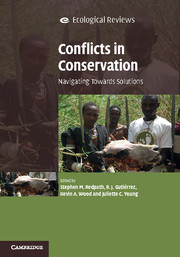Book contents
- Frontmatter
- Dedication
- Contents
- List of contributors
- Foreword by Georgina Mace
- Acknowledgements
- Part I Introduction to conservation and conflict
- PART II Contrasting disciplinary approaches to the study of conflict in conservation
- Part III Approaches to managing conflicts
- 14 Modelling conservation conflicts
- 15 Defining scales for managing biodiversity and natural resources in the face of conflicts
- 16 Mediation and conservation conflicts: from top-down to bottom-up
- 17 Designing and facilitating consensus-building – keys to success
- 18 Conservation conflict transformation: the missing link in conservation
- 19 Legislated collaboration in a conservation conflict: a case study of the Quincy Library Group in California, USA
- 20 Finding a way out of conservation conflicts
- Index
- Plate Section
- References
15 - Defining scales for managing biodiversity and natural resources in the face of conflicts
from Part III - Approaches to managing conflicts
Published online by Cambridge University Press: 05 May 2015
- Frontmatter
- Dedication
- Contents
- List of contributors
- Foreword by Georgina Mace
- Acknowledgements
- Part I Introduction to conservation and conflict
- PART II Contrasting disciplinary approaches to the study of conflict in conservation
- Part III Approaches to managing conflicts
- 14 Modelling conservation conflicts
- 15 Defining scales for managing biodiversity and natural resources in the face of conflicts
- 16 Mediation and conservation conflicts: from top-down to bottom-up
- 17 Designing and facilitating consensus-building – keys to success
- 18 Conservation conflict transformation: the missing link in conservation
- 19 Legislated collaboration in a conservation conflict: a case study of the Quincy Library Group in California, USA
- 20 Finding a way out of conservation conflicts
- Index
- Plate Section
- References
Summary
Researchers are documenting a wide diversity of conflicts that emerge among stakeholders about biodiversity conservation (Redpath et al., 2013). This body of evidence challenges the often stated assumption that all biodiversity has positive benefits towards human well-being (Maier, 2013) as different stakeholders may have very different views on the costs and benefits of different situations. The reality is that while much biodiversity conservation (hereafter ‘conservation’) benefits many humans, there can be real economic or social costs for conservation. The extent to which a given biodiversity component or conservation action represents a service or a disservice can vary with scale. For example, species that represent ‘public goods’ in general may represent ‘public bads’ locally (Bostedt, 1999). Large carnivores are a classic example. Because the costs of economic and social conflicts resulting from their presence are felt locally, attitudes to these species are often significantly less positive in the areas where they occur than in distant areas and cities (Karlsson and Sjöström, 2007; Box 15). However, the opposite situation may also occur. For example, in the harvest of wild ungulate populations the benefits (recreational opportunities, sale of licences and meat) of harvesting a ‘public good’ often fall to the local landowner while the costs (e.g. compensation for forest damage, vehicle collisions and infrastructure to mitigate vehicle collisions) usually fall on society as a whole (Kenward and Putman, 2011; Langbein et al., 2011; Reimoser and Putman, 2011).
This issue of scale represents a much neglected topic in conservation policy thinking, although it is emerging as a crucial discourse in a wide diversity of political sectors (Cash et al., 2006; Young et al., 2013a). In this chapter I will explore the issue of scale with relevance to conservation and conflict management by considering ecological, social and political dimensions of spatial scale (Cash et al., 2006). I will illustrate these relationships mainly using examples drawn from large mammal conservation in Europe, but with supporting reference from around the globe. My focus is on conservation within multi-use landscapes and not within protected areas.
- Type
- Chapter
- Information
- Conflicts in ConservationNavigating Towards Solutions, pp. 212 - 225Publisher: Cambridge University PressPrint publication year: 2015
References
- 8
- Cited by



